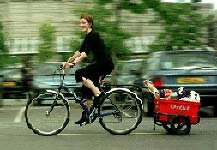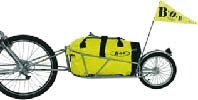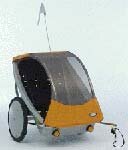|
 A trailer will allow you to make the most of your bike - for carrying children, doing your shopping, or touring further afield. A trailer will allow you to make the most of your bike - for carrying children, doing your shopping, or touring further afield.
For use in town, a simple 'box on wheels' allows you to leave the car at home and stock up with all you need. This Orbit trailer costs £99 and can be easily detached to wheel around with you. It's 60 litre capacity gives ample capacity, yet is no wider than your handlebars for getting though the traffic.
Two wheel trailers can also be used for touring, without affecting the handling of your bike in the way that a full touring load will do, packed into front and rear panniers. When you reach your destination, it's easy to leave your kit behind for a day ride. For carrying kit off-road a one-wheel trailer works better, following the track of your bike however rough the terrain. This BOB (Beast Of Burden) YAK trailer is expedition-tested and comes complete with a large waterproof bag. As used by many round-the-world cycle tourists and off-road riders.
 The most common use of trailers is for carrying children, allowing you to keep riding with a growing family. Children need to be able to sit up unsupported (about 5 months), and can be carried until the age of 5-6. The most common use of trailers is for carrying children, allowing you to keep riding with a growing family. Children need to be able to sit up unsupported (about 5 months), and can be carried until the age of 5-6.
 After that time, they will be able to move up to a trailer-bike, their own machine, or the back of a tandem. Trailers made for carrying children are usually made to higher standards, and are built with safety in mind. They are wider than luggage trailers, so they cannot tip even if they hit a kerb at full speed. A rain cover and a bug screen should both be fitted, together with full seat harnesses. Most trailers will carry up to two children, and are made to be highly visible. After that time, they will be able to move up to a trailer-bike, their own machine, or the back of a tandem. Trailers made for carrying children are usually made to higher standards, and are built with safety in mind. They are wider than luggage trailers, so they cannot tip even if they hit a kerb at full speed. A rain cover and a bug screen should both be fitted, together with full seat harnesses. Most trailers will carry up to two children, and are made to be highly visible.
Leggero trailers are built in Switzerland to the highest standards. The patented hitch allows quick and easy attachment to your bike, and spare hitches are available. The Classico is built around an aluminium chassis and is light (12.5kg) and strong. It also folds quickly and easily into a small package for transportation. The Twist is built around a custom moulding, with a high back for safety and support. It's a little heavier (15kg) and doesn't fold up as small.
|